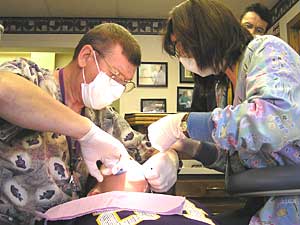|
Photos
|
February 2, 2005
Poor people in Minnesota have a tough time finding dental care. Most dentists in the state limit the number of Medical Assistance and MinnesotaCare patients they see, because those programs don't fully reimburse dentists for the cost of treatment. A new dental clinic in Park Rapids is taking a new approach to dental access by integrating dentistry into a comprehensive public health program.
Park Rapids, Minn. — Low-income people are often turned away when they try to make an appointment with their local dentist. Doug Stewart, from the Cass Lake area, said he and his wife felt lucky when they finally got appointments at the new clinic in Park Rapids, even though they had to drive nearly an hour to get there.
"I haven't been to a dentist in eight years," said Stewart. "I don't like dentists, for one. But part of the problem is getting a dentist to see me. It's definitely an obstacle."
Stewart is on MinnesotaCare, a health insurance program subsidized by the state.
"It's been a problem for a long while," he said. "My wife called around, and she found this place down here a couple weeks ago. Otherwise, we were going to have to drive all the way to Brainerd, which was even farther away."
The new Community Dental Clinic in Park Rapids is attracting Medical Assistance and MinnesotaCare patients from all over the state. It's operated by St. Joseph's Area Health Services hospital. The idea came from Dr. Daniel Rose, a retired University of Minnesota dentist. Rose says one of the key elements to the program is that it treats access to dental care as a public health problem.
"Many times public program patients receive episodic care," said Rose. "A tooth hurts, I go to the dentist, they slip me in somewhere in their schedule, they take care of that one problem and I'm on my way."
Rose says that stop-gap approach often leads to more dental problems later on. He says what's unique about the clinic is that it offers low-income patients comprehensive care that goes beyond dentistry. There's a public health office in the same building. Before patients are seen by a dentist, they're screened by a public health nurse.
"We see bi-polars who haven't taken their medication in a year and a half," Rose said. "That's just one example of it. They might be coming in here because they have a toothache. They haven't seen a physician in a year and a half, or a psychiatrist. Those are the kind of issues that we see."
Many private dental offices shy away from public health patients, because they don't want to deal with the mounds of bureaucratic paperwork that go along with state programs. Rose's model streamlines those administrative obligations to make them more efficient. The approach is being closely watched by the state Department of Human Services and the Minnesota Dental Association.
"I would like to see the state of Minnesota look at this model and say, 'You know, why don't we set up a public health dental clinic in however many regions and ... communities can fight about who gets the clinic,'" said Rose, "and then maybe even contract directly with the hospital here to provide the care, rather than contracting with an insurance company. Just provide the hospital here X number of dollars a year to provide care for that region."
St. Joseph's Hospital got financial support for the clinic from foundations and the local community. The hospital's president, Peter Jacobson, says the clinic's proactive approach to dental and health care will save money over time.
"We're going to be able to make ends meet with this program," said Jacobson. "Our goal was not to make money on it. And if we lose a little money on it, that's OK because it's part of our mission, if we have to subsidize this to a degree."
Jacobson says the hospital has applied for grants to eventually turn the dental clinic into a training center for University of Minnesota dentistry students. He says the goal is to attract more dentists to this kind of work.
Dental industry officials say access problems in Minnesota are likely to get worse, since 40 percent of dentists in the state are expected to retire in the next decade.







